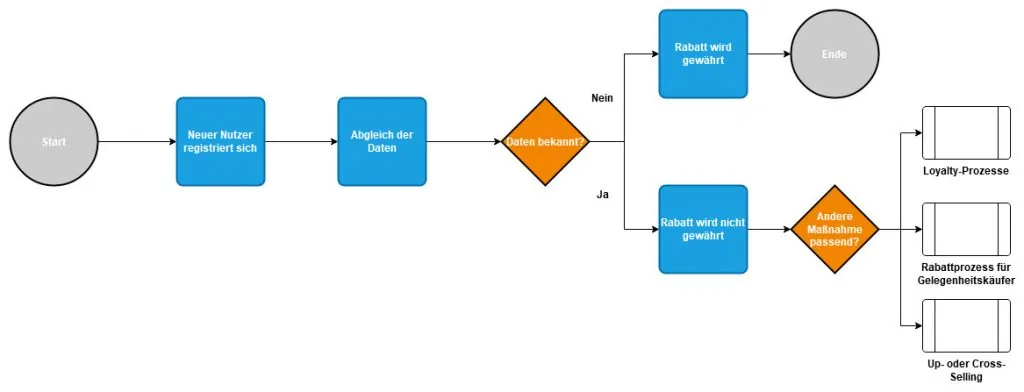Business rules describe rules that are defined for automated processes or for processes whose degree of automation is to be established or increased. Business rules thus usually have their background in the field of (business) informatics, digitization and other technical matters. However, they can also describe business matters.
Example: new customer discount
For example, a new customer discount of twenty percent when initially registering in an online shop is both a business, economic rule and a process-related rule in the digitized creation of a customer account and in the subsequent order process.

Depending on whether the customer is already registered, the discount is granted or a further process is started based on the available data.
Advantages of business rules
Business rules are not strategic guidelines in themselves, but instructions to be followed; they apply to a company’s workforce, processes, business practices and IT systems. Ideally, business rules are stored and defined centrally, for example in a requirements document for software developers. If the business rules are properly maintained, they can help the company and in particular the relevant processes to achieve their goals more effectively, minimize costs, remove obstacles, optimize communication and comply with legal requirements.
Business rules in application software and BRMS
When business rules describe how a computer program or a process controlled by software should run, they are comparatively simple if-then scenarios. However, when accumulated, they greatly simplify or accelerate very complex processes by running them automatically. However, a large number of business rules can increase the complexity and confusion of a process or program and increase the risk that individual rules will not complement each other, but also contradict each other. That is why there are so-called business rule management systems (BRMS) for this purpose. These make it possible to develop and deploy processes and computer programs based on business rules. The GRMS is designed to make the business rules centrally available to other programs or requirements at any time by separating the rules from other levels of the software program.
In contrast, business rules and the corresponding BRMS in rule-based systems take on a much higher degree of complexity in the broader context of artificial intelligence.
Business rules and rule-based systems
Rule-based systems provide one way of representing business rules. A rule-based system consists of three elements: the fact base, the rule base and the business rule engine. The fact base is a database containing facts from the business processes. The rule base is a rule database containing all the rules. The business rule engine forms the control system that identifies the rules in a business process (based on the fact base), applies the appropriate rules and also updates the rule database with new rules.
A characteristic of a rule system is a query according to the If-Then-Else scheme. This breaks down and displays a specific rule. Particularly in the case of automated processes, very complex business rules can arise that express a supposedly simple fact in a complex way, but nevertheless make the business process sustainable and more efficient.
Example: rush order
A company’s decision to take on a rush order is always a procedural challenge. What criteria are used to accept a rush order and what are the consequences for all the processes involved? In this case, business rules not only make the decision-making process easier, but also ensure that the associated processes continue to run quickly and smoothly.
Relevance of business rules and BRMS
Every company has business rules, even if they are not written down and stored anywhere. Products and services are procured, manufactured and marketed at an ever-increasing pace. In doing so, they are subject to numerous regulations and requirements, such as laws, quality standards, specifications and guidelines, which affect all areas of a company, such as production, accounting, sales or IT.
Thus, all business processes already operate within a framework defined by rules, which is expanded by business decisions. Two types of business process automation can be distinguished based on the way business rules are formulated and stored in their entirety. On the one hand, there are simple decisions that are made very frequently, as in the example of the new customer discount above; on the other hand, there are very complex decisions that occur rarely but involve a high level of business complexity, as in the example of the rush order.
Centrally managed business rules enable a company to keep the practiced processes and applications flexible (and thus change them if necessary), to check them, to make them transparent and to simulate them using a BRMS.
Summary
Business rules are used to establish automated processes, make them transparent and increase their efficiency. They can include both technical processes and business instructions. A business rule management system (BRMS) is used to store and manage business rules.
Further links:
